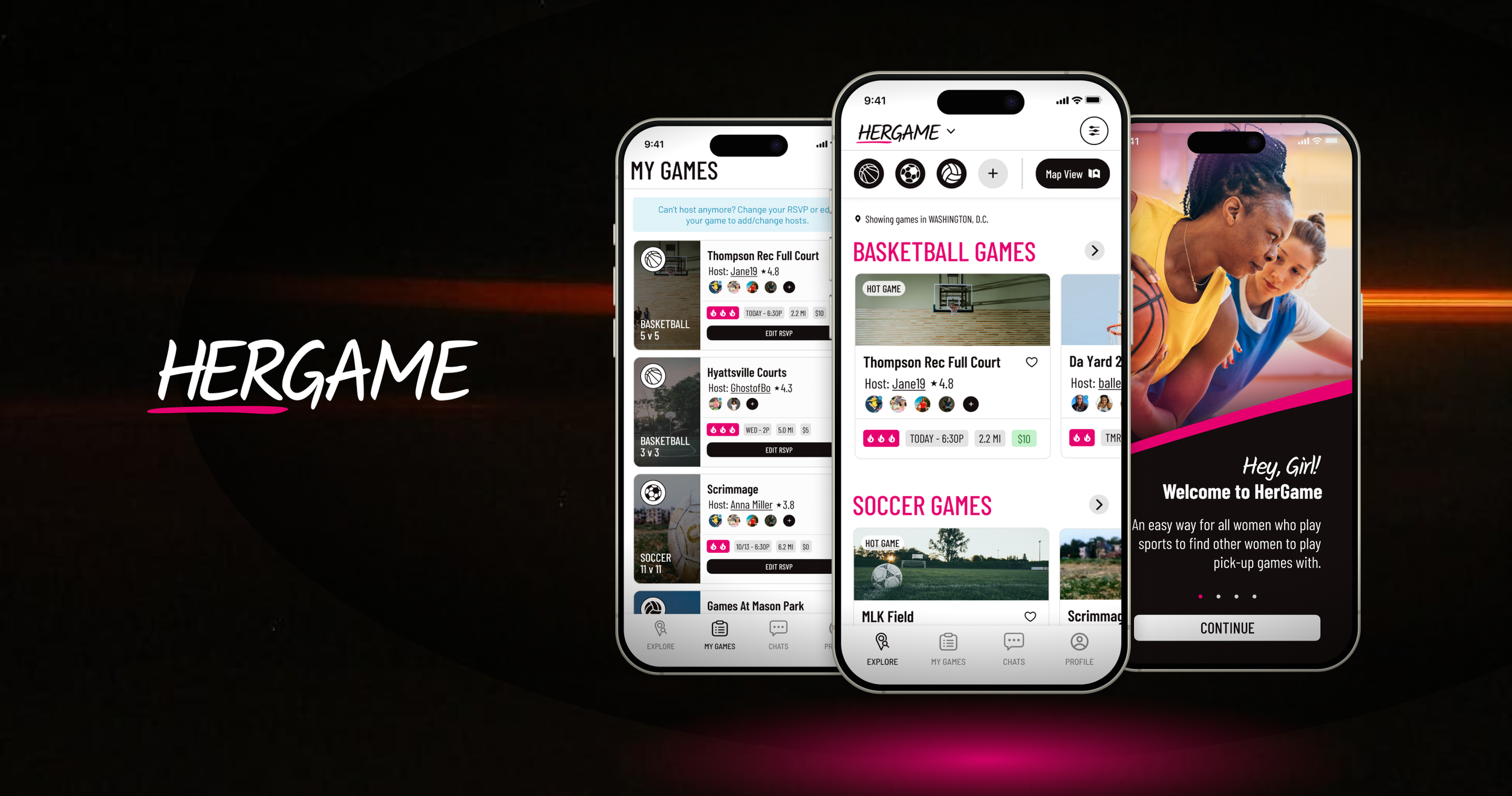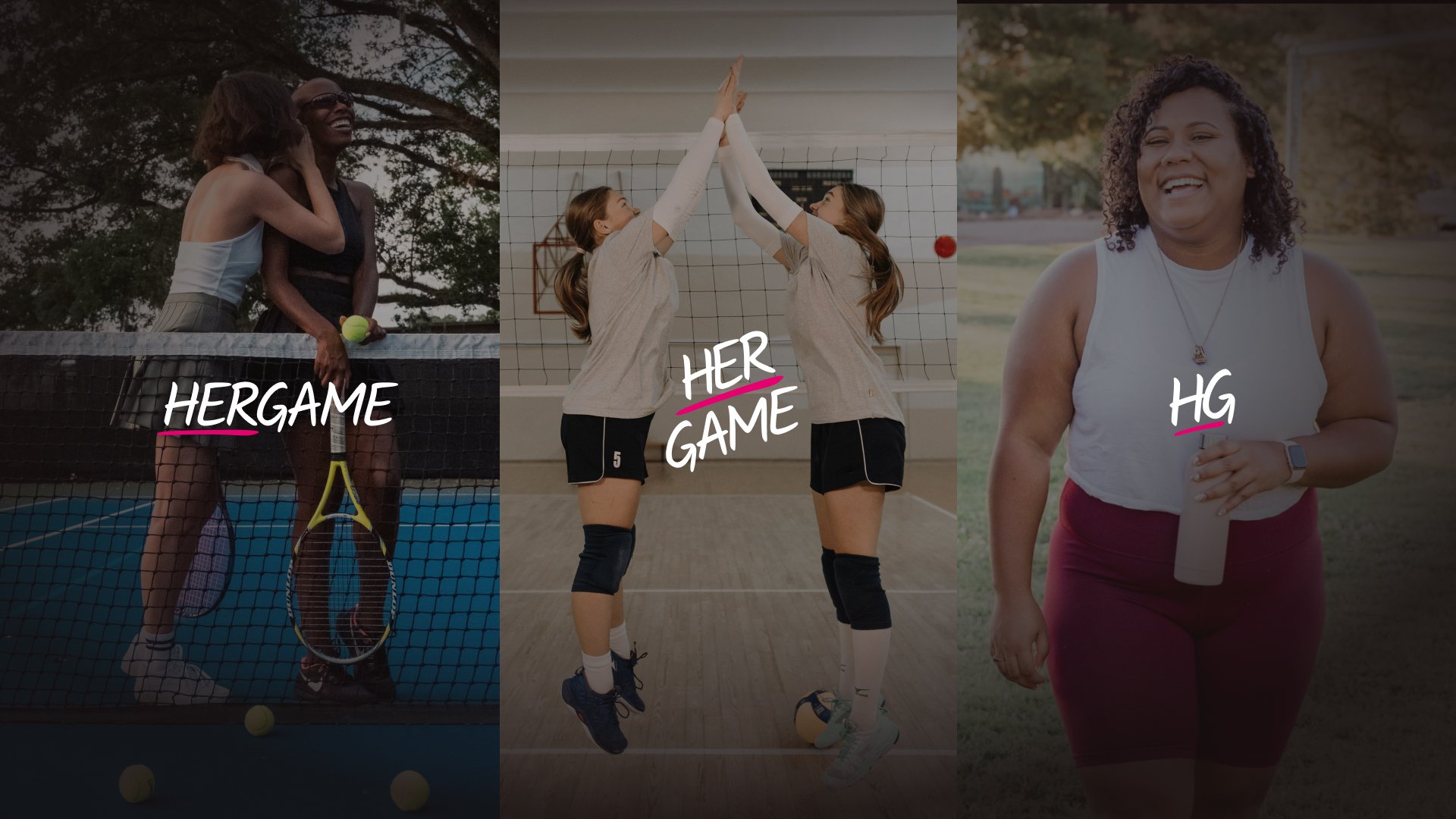UX RESEARCH & DESIGN • UI DESIGN • APP DESIGN
Connecting Women To Sports & Community
Year: 2024 - 2025
Role: Sole Product Designer
Project Type: Personal Passion
Time: (Phase 1) 6 Months
Tools: Figma, Miro, Fig Jam

The Challenge
WHY HERGAME?
HerGame is a product designed to help women find and join pick-up games to play with one another and build community.
While pick-up sports are a great way to stay active and meet people, they’re not always accessible or safe for women. HerGame was born out of a common, frustrating experience: wanting to play, but not knowing where to go, or worse, showing up and not feeling welcome or having uncomfortable interactions with male players. For many women, myself included, access to casual sports is limited not by interest, but by invisible barriers:
A lack of organized, affordable opportunities.
The dominance of male participants in informal games.
Difficulty finding other women to play with.
The social discomfort or unpredictability of open and competitive, mixed-gender environments.
HOW REAL WOMEN FEEL
“Between work and family obligations, it’s tough to find time to play sports. Even tougher to find other women to play with consistently.”
“In co-ed games, if you’re not as skilled, it’s because you’re ‘just a girl’, but if you’re good or better, then the tone sometimes shifts to something more aggressive and unfriendly. The unpredictability is exhausting.”
“It’s definitely frustrating at times to be a woman playing in a male-dominated environment because, like in many other areas, we have to constantly prove ourselves.”
“I have a hard time finding new ladies to play with. And how do I know that they are at my level? It would be so great to find these women!”
A COMMUNITY-FOCUSED SOLUTION
HerGame isn't just aiming to solve logistical problems — the goal is to create social permission and structural support for women to show up, participate, and build community through sport.

Getting to Know Her
I began by conducting a survey and interviewing a range of recreational athletes — from former college players to women just getting into the game. I knew what kind of challenges and frustrations I was facing as a recreational female athlete, but it was important for me to hear the real-world frustrations of others. The goal was to understand not just what potential features they wanted, but what was keeping them from playing in the first place.
These insights shaped the overall direction: keep it simple, supportive, and focused on ease of connection.
KEY INSIGHTS
86% of respondents found it difficult to find and join games consistently
Scheduling conflicts, unclear skill levels, and no-show players made participation unreliable
Users wanted a platform that felt casual, easy to use, and tailored to how they would want to play
Women can face varying degrees of sexism from male athletes in a co-ed environment.
Dual Design Focus
Designing for Belonging
With these insights, every design decision was filtered through a central question: Does this help women feel more comfortable showing up to play? Rather than starting with features, I started with intentions:
Connection: How can the app foster trust and familiarity before players even meet on the field?
Commitment: How can we encourage reliability without guilt or pressure?
Comfort: How can the design itself signal safety, fun, and belonging?
What followed was a design process focused not just on usability, but on emotional clarity — reducing intimidation, reinforcing autonomy, and normalizing casual participation.
CONNECTION
Building connection with intention meant carefully synthesising survey response data to narrow in on the needs that stood out most.
COMMITMENT
Getting players to commit to games meant thinking of ways to make it easy to find games and assess them for playability and comfort level.
COMFORT
Comfort through design meant considering language, tone, and user privacy throughout the system.
Designing for Simplicity & Confidence
I also focused on creating an experience that felt straightforward and familiar, even for first-time users. Rather than overwhelming the app with features, I prioritized clear navigation, intuitive game discovery, and easy game creation.
Other core considerations included:
Streamlined flows to reduce friction at sign-up and game join points
Gentle nudges to encourage attendance and follow-through
Energetic design that felt modern and welcoming without leaning too playful or too corporate
Early usability testing helped refine language, improve clarity around RSVP expectations, and ensure users could confidently find or host games in just a few taps.
STREAMLINED, GENTLE, ENERGETIC
Streamlined flows meant simple actions for quick updates and notifications between players and hosts
Gentle nudges meant small reminders on the benefits of being communicative and reliable, and making it easy to change your status
Energetic design meant iterating on design decisions that provided as much helpful information as possible without being too cluttered or difficult to navigate.
Sample wireframe evolution for reviewing your list of games and editing your RSVP status.
User Reception
GIRLS JUST WANNA HAVE FUN
Two rounds of user testing online and in-person have shown that women are excited for something like this product! Even more casual players and a few men that have also participated in testing are intrigued and say that they would share something like this with the more athletic women in their families and friend circles.
The most consistent positive feedback was that users wished something like this had been around for them to use in the younger years of their playing days.
Testing session held at a cafe
Lessons I’m Keeping in Mind
Designing HerGame has reinforced a few key lessons so far:
Design with a focused audience. It’s tempting to try to accommodate every use case, but designing around a clear primary user creates a stronger foundation.
Validate early and often. Some flows I assumed were obvious turned out to be less intuitive to others — user testing was essential.
Small touches matter. Tone, language, and visual contrast all impact how confident and comfortable users feel in an app.

What’s Next?
LOOKING AHEAD
Next steps include building out messaging and invite flows, refining the venue participation strategy, and preparing for MVP development and closed beta testing. The long-term goal is to create a platform that supports a wide range of play styles — whether someone wants to shoot around with a few people or organize a full scrimmage.
FINAL TOUGHTS
At its core, HerGame is about making it easier for more women to play more often. By focusing on ease, reliability, and connection, the app aims to bring more fun — and a little less friction — to pick-up game culture for women.







